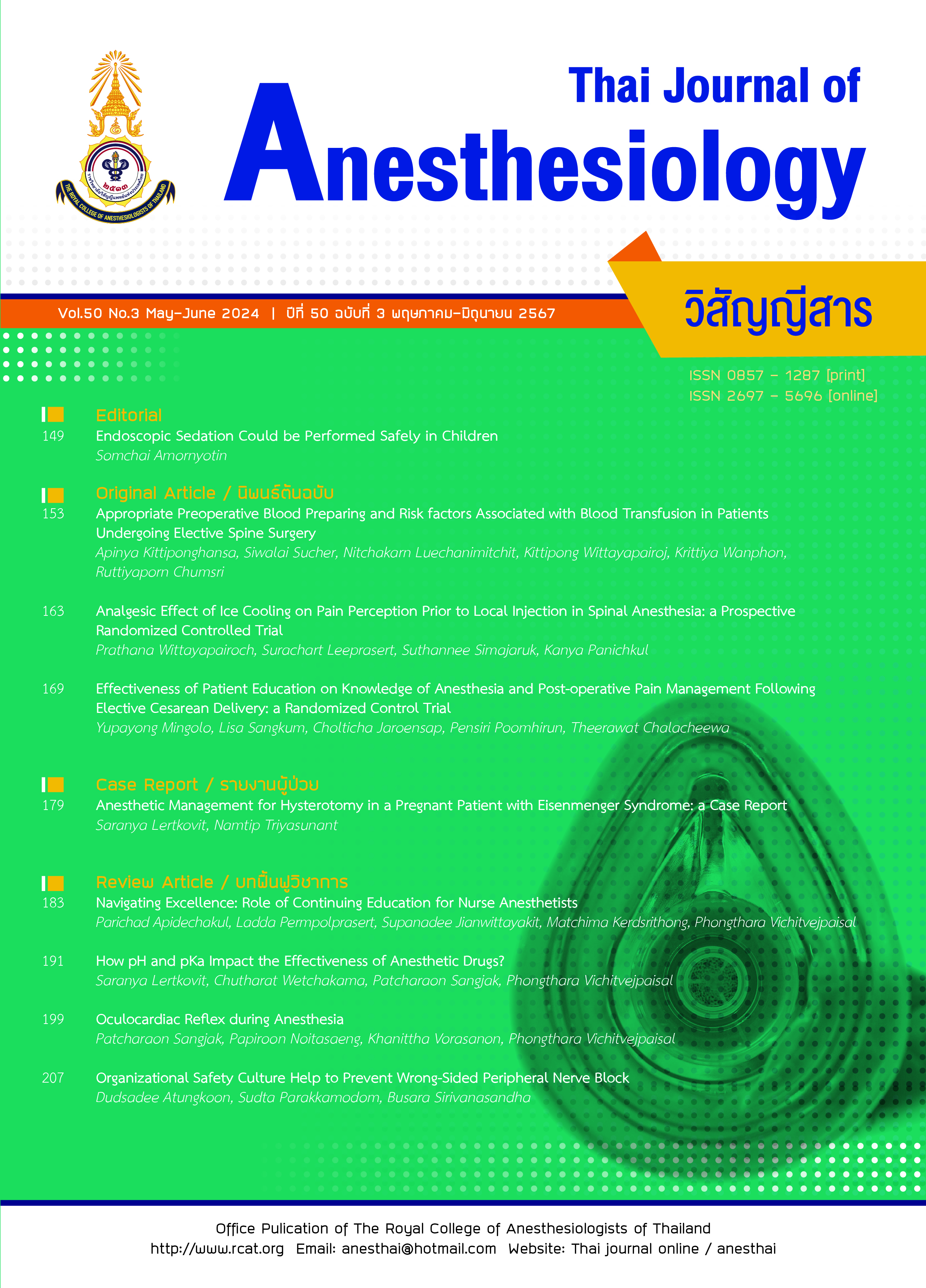Analgesic Effect of Ice Cooling on Pain Perception Prior to Local Injection in Spinal Anesthesia: a Prospective Randomized Controlled Trial
Main Article Content
Abstract
ntroduction: Spinal anesthesia is commonly used for many types of surgeries. To reduce the pain associated with spinal needle, subcutaneous local infiltration is administered beforehand. However, this process may still cause some pain. Previous studies have demonstrated that cooling the site of needle puncture with ice can decrease pain perception during needle insertion. Our study is aimed to evaluate the impact of ice cooling on pain perception during local infiltration in spinal anesthesia (SA). Methods: This prospective randomized controlled trial was conducted from August 2018 to March 2019. Participants aged 18 to 65 years undergoing SA were divided into two groups. Group C received standard SA, while group E received SA with ice cooling applied 5 min before local infiltration. Data on patient characteristics, pain scores during needle insertion and local injection, anxiety levels, patient satisfaction, and complications were recorded. Results: The study included 102 participants. Baseline characteristics were similar between two groups. The pain scores during needle insertion and local injection for local anesthesia showed no significant differences between the groups. Preoperative and postoperative anxiety and patient satisfaction scores also showed no significant variation. No severe complications related to procedure were reported. Conclusion: The application of ice cooling before local infiltration in SA showed no significant difference in the pain score during needle insertion and local infiltration for local anesthesia when compared to standard technique.
Article Details

This work is licensed under a Creative Commons Attribution-NonCommercial-NoDerivatives 4.0 International License.
References
Weinstein SM, Poultsides L, Baaklini LR, et al. Postoperative delirium in total knee and hip arthroplasty patients: a study of perioperative modifiable risk factors. Br J Anaesth. 2018;120:999-1008.
Liu SS, Strodtbeck WM, Richman JM, Wu CL. A comparison of regional versus general anesthesia for ambulatory anesthesia: a meta-analysis of randomized controlled trials. Anesth Analg. 2005;101:1634-42.
Sansonnens J, Taffé P, Burnand B, ADS study group. Higher occurrence of nausea and vomiting after total hip arthroplasty using general versus spinal anesthesia: an observational study. BMC Anesthesiol. 2016;16:44.
Orbach-Zinger S, Aviram A, Fireman S, et al. Severe pain during local infiltration for spinal anaesthesia predicts post-caesarean pain. Eur J Pain. 2015;19:1382-8.
Leff DR, Nortley M, Dang V, Bhutiani RP. The effect of local cooling on pain perception during infiltration of local anaesthetic agents, a prospective randomised controlled trial. Anaesthesia. 2007;62:677-82.
Haynes JM. Randomized controlled trial of cryoanalgesia (ice bag) to reduce pain associated with arterial puncture. Respir Care. 2015;60:1-5.
Bastami M, Azadi A, Mayel M. The use of ice pack for pain associated with arterial punctures. J Clin Diagn Res. 2015;9:JC07-9.
Mahshidfar B, Shevi SC, Abbasi M, et al. Ice reduces needle-stick pain associated with local anesthetic injection. Anesth Pain Med. 2016;6:e38293.
Hengsawat K. The efficacy of cryopatch in acute pain relief during spinal anesthesia. Thai J Anesthesiol. 2021;47:10-5.
Leźnicka K, Pawlak M, Gasiorowska A, et al. Individual characteristics and pain sensitivity during pregnancy-a cross-sectional study in pregnant and non-pregnant women. Int J Environ Res Public Health. 2022;19:14151.
Harrison JL, Davis KD. Cold-evoked pain varies with skin type and cooling rate: a psychophysical study in humans. Pain. 1999;83:123-35.


